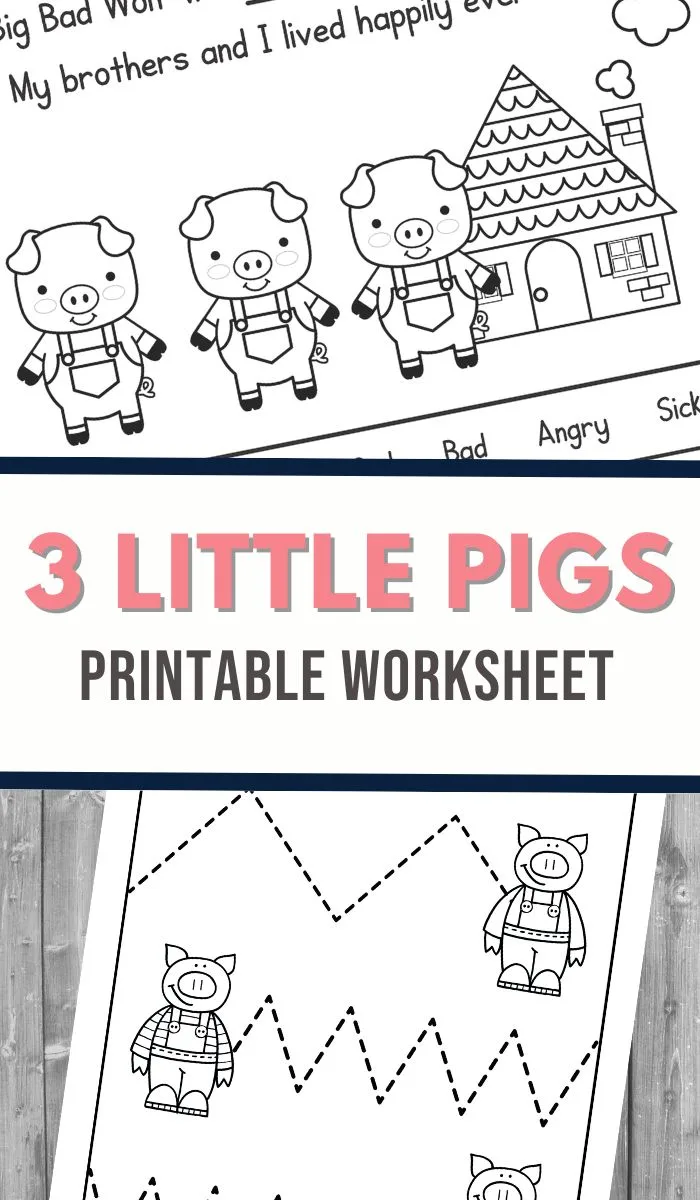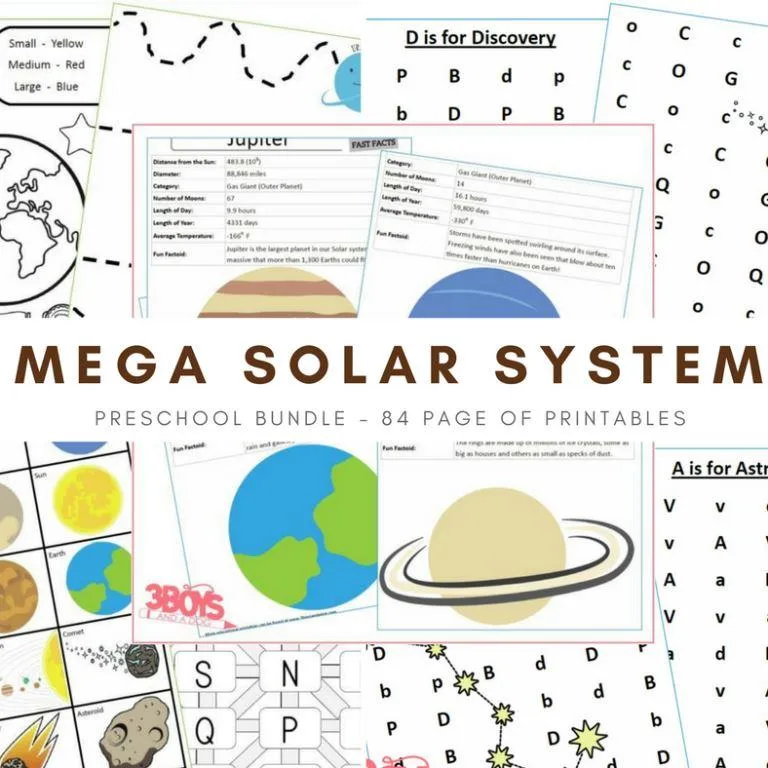The Three Little Pigs is such a great story of bullying, problem-solving, and overcoming adversity. Plus, it is just plain fun.
Teach your children art, fine motor skills, handwriting, and more with this 3 Little Pigs Unit Study.

This post is an example of why themed unit studies are a great resource for learning activities for kids!
What is The Three Little Pigs Story?
The Three Little Pigs is a classic story that has been beloved by children for generations. The story tells the tale of three pigs who are chased by a fearsome wolf.
The first two pigs are quickly caught by the wolf, but the third pig is able to outsmart the wolf and build a house that is strong enough to withstand his attacks.
The story teaches important lessons about bullying, problem-solving, and overcoming adversity.
In addition, the story is also extremely entertaining, with characters that are both relatable and lovable.
The Three Little Pigs is truly a timeless classic that will continue to entertain and enlighten children for many years to come.

Art:
Art is an essential part of a well-rounded education. It helps children to develop critical thinking and problem-solving skills, and it also allows them to express themselves in a creative and unique way.
By teaching art within the context of other subjects, kids are more likely to retain the information.
- Three Little Pigs: Masks (preschool reading comprehension)
- Three Little Pigs: Circle Pig (preschool shapes)
- 14 Fun Pig Crafts for Kids
- Mmm…Mmm…Muddy Pig
- I know a Wee Piggy (story and craft)
Handwriting:
In recent years, there has been a growing movement to abandon traditional handwriting instruction in favor of typing. However, research has shown that there are many benefits to teaching children how to write by hand.
For one, handwriting requires the use of fine motor skills, which helps to promote the development of coordination and Base thought processes.
In addition, handwriting is a slower process than typing, which gives children more time to process information and form thoughts.
And finally, handwriting is associated with improved memory and retention; in one study, students who took notes by hand were better able to remember and recall information than those who typed their notes.
Given the many benefits of handwriting instruction, it is clear that this educational foundation should not be ignored.
- Pre-writing starts with fine motor and scissor skills. These 3 Little Pig Cutting Practice Sheets can help with just that.
- These 3 Little Pigs Worksheets can help with tracing.
Math:
Mathematical knowledge is not only a fundamental component of many professions (such as architecture, engineering, and even medicine), but it is also critical for success in everyday life.
Those who have a strong foundation in math are better equipped to manage their finances, plan for the future, and even make sense of the world around them.
For children, math provides a way to make sense of their surroundings and develop important problem-solving skills. It also lays the groundwork for higher-level thinking and reasoning.
- 3 Little Pigs Math Activities and Freebies
- 3 Little Pigs Big and Little Printables
- Three Little Pigs Math Activities
Reading:
Reading is a complex cognitive process that involves the simultaneous use of a number of different skills. These skills include phonemic awareness, phonics, fluency, vocabulary, and comprehension.
Children who struggle with any of these skills are at risk of reading difficulties.
Early intervention is essential for helping children develop the skills they need to become successful readers.
There are a number of reasons why it is important to teach reading skills to children.
First, reading is a critical life skill. Employees who can read well are more likely to be successful in their careers than those who cannot.
In addition, reading is closely linked to other important academic skills such as writing and mathematics. Finally, research has shown that children who are strong readers tend to have higher self-esteem and better social skills than those who struggle with reading.
For all of these reasons, it is clear that teaching reading skills to children is an essential part of their education.
- 3 Little Pigs Story Sequence
- Pig Pig Goes to Camp: Fre Printable
- Word Find Placemat
- 3 Little Pigs Easy Reader Printable
Spelling, Vocabulary, Language Arts:
Language arts, spelling, and vocabulary skills are important for children to learn for a number of reasons.
First, these skills provide a foundation for reading and writing. Children who can read and write well will be better equipped to succeed in school and beyond.
Second, these skills help children to communicate effectively. Children who can express themselves clearly will be better able to interact with others and build relationships.
Finally, these skills help children to understand the world around them. Children who can read and write well will be able to access information and find solutions to problems more easily.
In short, teaching language arts, spelling, and vocabulary skills to children is important because it helps them to develop essential skills that will benefit them throughout their lives.

What is a Unit Study?
A Unit Study is a great way to cover all subjects while sticking to one big theme. A unit study is an educational approach that emphasizes the study of a particular topic or “unit” over a period of time.
Unlike a traditional curriculum, which is organized around separate subjects such as math, science, and English, a unit study allows students to explore a single topic from multiple perspectives.
Unit studies are often used in homeschooling and other alternative education settings, but they can also be adapted for use in a traditional classroom.
When designed properly, unit studies can be an excellent way to promote deep learning and encourage students to make connections between different disciplines.
What’s more, a unit study is not just limited to academic subjects; it can also be used to teach practical skills such as cooking or carpentry. The sky is the limit when it comes to unit studies!
What are the benefits of a Unit Study?
There are many benefits to using a unit study approach to learning.
For one, it allows students to go deeply into a subject, exploring all its nooks and crannies. It also encourages critical thinking and problem-solving skills, as students must make connections between different concepts in order to understand the big picture.
And because each student learns at his or her own pace, everyone is sure to stay engaged throughout the entire unit.
What are the benefits of learning about a subject all at once?
Learning about a subject all at once, rather than piece by piece, can be incredibly beneficial in the long run.
This approach allows you not only to gain an overview of what is covered within the subject, but also helps to form relevant connections between previous knowledge and new information that can be deeper and more cohesive.
Furthermore, with an increased understanding of a subject as a whole, it can help to create an overall more comprehensive picture.
With these benefits in mind, focusing on learning about a subject all at once provides learners with greater confidence and improved long-term skills retention for future application.
At what age are learning printables good for kids to start using?
Learning printables can be a great tool to introduce kids to new concepts, but the age at which they are appropriate for use depends on a few factors.
Generally speaking, the younger the child is, the more basic and straightforward the printable should be. It’s important to consider their developmental level when deciding what type of materials may best complement their learning journey.
For younger children, it may be beneficial to look for printables with fewer words or ones that have visual cues to aid comprehension. As kids get older and develop literacy skills, worksheets with larger amounts of text can provide educational enrichment.
Ultimately, it’s vital to select a printable that is suitable for your child’s level of development while also furthering their education in a fun and interactive way.
Shop My Learning Printables:
The following homeschool picks of mine can be found in my shop. Simply click the image that interests you!
What is the story of the 3 Little Pigs?
The story of the three little pigs is a timeless classic from folklore which has been handed down and retold for generations.
It follows the journey of three pigs and their attempts to build homes that will protect them from an approaching danger—the wolf.
The first two pigs’ dwellings are constructed with straw and sticks respectively, while the third pig builds his house of bricks. When the wolf comes knocking, only the third pig is secure and able to outwit his pursuer.
The story serves as a lesson to children on the importance of hard work in providing a safe home.
Furthermore, it contributes to the classic motif of good triumphing over evil found in many stories around the world.
Is a unit study helpful for kids?
Research shows that unit studies may be an effective way to facilitate learning for children. Unit studies combine lesson plans and activities for related topics such as history, math, geography, science and the fine arts, allowing students to look at these topics all together to gain a more comprehensive understanding.
By studying all the subject areas in relation to each other through a theme or unit of study, students can recognize patterns and connections between various topics and develop creative thinking skills.
Moreover, utilizing this method helps create a relaxed environment where both parents and kids can actively participate in the learning process.
Ultimately, unit studies appear to be beneficial in facilitating knowledge acquisition for children.
Whether you’re a teacher looking for a new way to engage your students, or a parent searching for an educational approach that works for your family, a unit study might just be the perfect solution.









Deepika
Wednesday 16th of March 2022
I loved the three little pigs!!
Kelli Miller
Saturday 26th of March 2022
I'm glad you love them! Thank for stopping by :-)